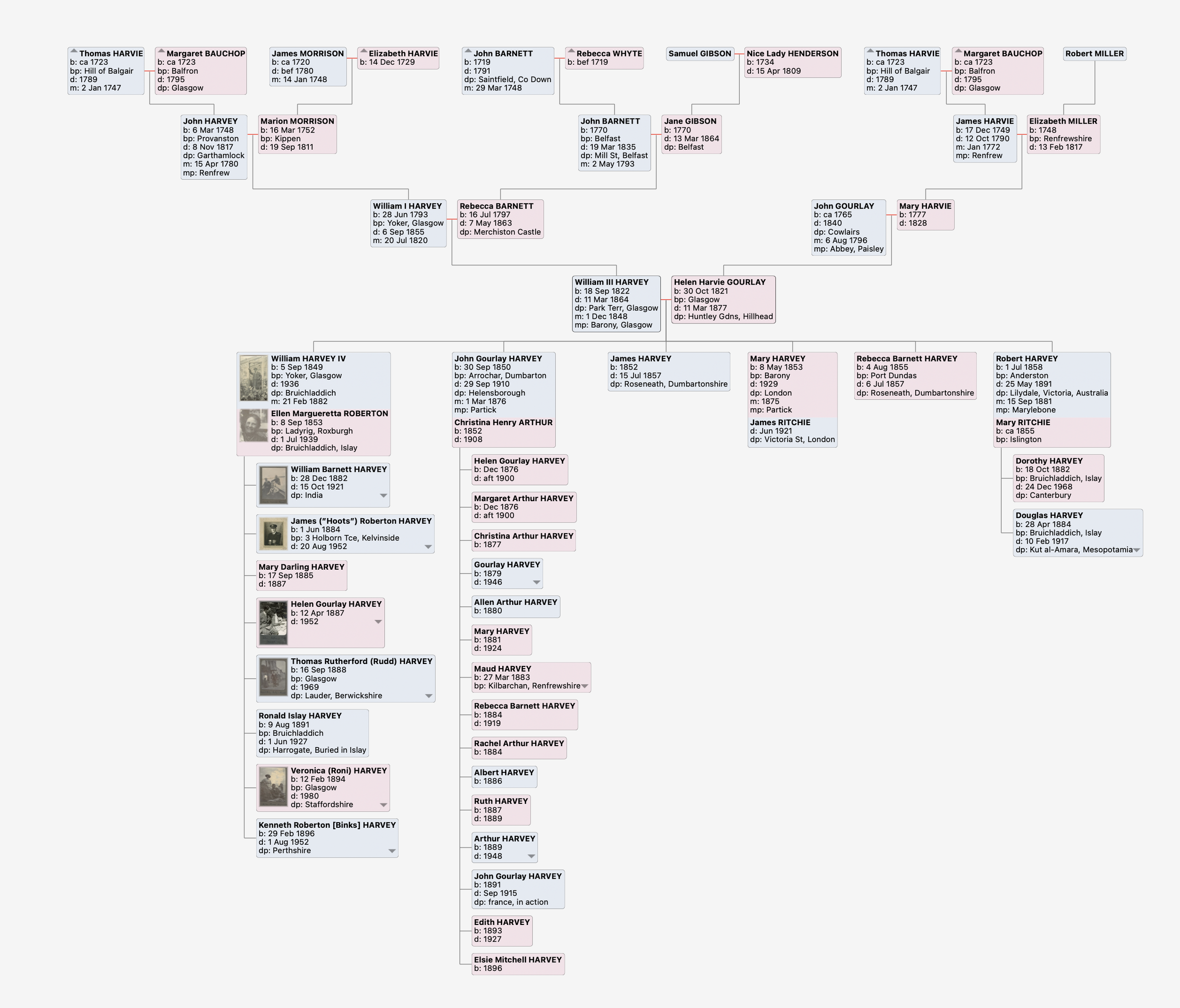HARVEY brothers starting distilling at BRUICHLADDICH
As can be seen from the tree below, William III HARVEY and Helen Harvie GOURLAY had four sons, three of whom survived and went on to found BRUICHLADDICH. William HARVEY and his brothers John Gourlay HARVEY and Robert HARVEY founded this wonderful distillery on the shores of Loch Indaal in Islay in 1881. Their ancestors had previously started distilling at Hill of Balgair in the 1700s, before moving to Glasgow. At various times in Glasgow, branches of the family had distilleries in Paisley, Yoker, Port Dundas and Dundas Hill. William IV and his grandfather William I had been distilling at Yoker on the north bank of the Clyde, while his brothers were also running Dundas Hill in Glasgow, having inherited it on the Gourlay side.
At Bruichladdich, Robert designed the building, William was the main funder and John provided the distilling expertise. Thomas Rutherford HARVEY, known as Rudd, provides a frank narrative of the early years of Bruichladdich, originally hand-written shortly before his death- the history, if you scroll below the family tree, is based on it and a full transcript is provided at the page ‘Rudd’. Amongst other things, Rudd’s account clarifies which Robert and which John are the actual brothers at Bruichladdich- there are indeed a whole lot of them across the different distilleries!
Click for HARVEY; 1600s and 1700s early HARVIEs; Rudd; index and homepage ;
The HARVEY story of Bruichladdich
The Harveys were a dynastic whisky family, owning Glasgow’s Yoker and Dundas Hill distilleries. William Harvey (III) died in 1864 at the age of forty-one when his three sons William (IV), John and Robert were only fifteen, fourteen and five respectively. The boys’ inherited distilling interests were looked after by their uncles Barnett and John (Snr).
William started his working life as a clerk in the Glasgow sugar trade, where he progressed to become a successful broker. John joined the family distilling business with his uncles, while Robert, the youngest, eventually took a degree in engineering and set up his own distillery design company.
Then in 1881 the three young brothers had a bright idea - why not combine their expertise and inheritance to build a third Harvey distillery? Robert would build it, John would run it and William would provide the business acumen. The plan was that, working together, managing one distillery each, they could market their own whisky brand as a self-contained whisky business. Perfect! What could possibly go wrong?
The idea had two catalysts. First, the Spirit Act came in to force in 1880 shifting the duty payable from malted barley to the finished product - whisky. It also created bonded warehouses which permitted the deferral of tax until the whisky was sold. Second, the invention of the steam ‘puffer’, a flat-bottomed commodity-moving vessel that allowed coal and extra barley to be brought to Islay, transforming the economics of island distilling.
The naive young men had a vision. They believed that the combination of three distilleries run by the family, Yoker, Dundas Hill and the soon-to-be Bruichladdich - would provide the ideal mix for the Harvey's to dominate the Scotch whisky business. So, showing considerable entrepreneurial flair and bolstered by youthful enthusiasm, the three brothers embarked on building Bruichladdich in 1881.
Originally destined for the opposite side of the Rhinns where a more regular water supply was present from Loch Gorm, it was finally (and sensibly) decided to build on the western shore of Loch Indaal which provided a more sheltered anchorage.
The Harveys decided to use revolutionary new building methods (cavity wall construction) and materials (concrete) - reinforced with pebbles from the foreshore in front of the distillery. Building contractor John MacDonald of Tollcross in Glasgow erected a 'solid and handsome structure' formed in a square around a courtyard, while Bennet and McLaren, also of Glasgow, undertook the coppersmith work.
Robert's simple yet avant-garde design was inspired. Built to an exceptionally high standard, it incorporated several nifty new ideas, and was specifically designed to produce the purest spirit possible from tall, elegant stills.
This was Islay’s first dedicated full-scale, purpose-built distillery. Uber-modernist in its day, the testament to the design is that little has changed since. The steam power has given way to electricity, the kiln was dismantled and the floor maltings stopped at some point after 1945, but apart from that, it is all still there, still producing the purest spirit in Scotland, (according to Pip Hills, the founder of the Scotch Malt Whisky Society).
